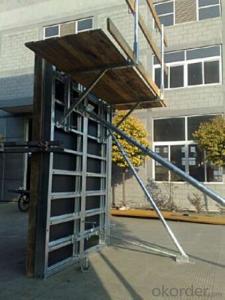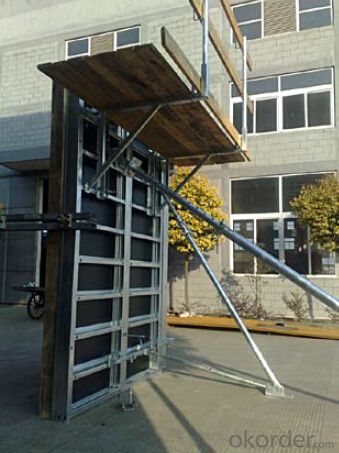Steel-frame Formwork Platform
- Loading Port:
- China Main Port
- Payment Terms:
- TT OR LC
- Min Order Qty:
- -
- Supply Capability:
- -
OKorder Service Pledge
OKorder Financial Service
You Might Also Like
Steel-frame Formwork SF-140
Characteristics:
◆ Few parts for fast forming.
◆ Max. Concrete pressure: 80KN/m2.
◆ Hot-dip galvanized steel frame.
◆ The thickness of plywood is 18mm & the panel is 14cm.
◆ Compatibility with Hunnebeck Manto system due to similar edge profile.
System Details & Application:
◆ Neat joint and fast assembling with aligning panel clamp.
◆ Flexible panel arrangement and height extension.
◆ The selection of panels.
◆ Kinds of panel connectors.
◆ Corner clamp application.
◆ Length adjustment application.
◆ Height adjustment & aligning strut.
◆ Walkway bracket & platform.




- Q: Can steel formwork be used for both new construction and renovation projects?
- Yes, steel formwork can be used for both new construction and renovation projects. Its durability, strength, and versatility make it suitable for various types of construction projects, whether it involves building from scratch or renovating existing structures. Steel formwork provides a sturdy and reusable solution that can be easily adapted to different project requirements, making it a popular choice in the construction industry.
- Q: How does steel formwork affect the overall constructability of the structure?
- The overall constructability of a structure is greatly enhanced by the use of steel formwork. Firstly, the high strength and durability of steel formwork enable it to withstand the pressure and forces exerted during the concrete pouring and curing process. This strength allows for the construction of taller and more complex structures, providing greater design flexibility. Furthermore, the reusability of steel formwork significantly reduces construction time and costs. Unlike traditional wooden formwork, steel formwork can be easily dismantled, cleaned, and reassembled for future concrete pours. This eliminates the need for continuous formwork fabrication, resulting in faster construction cycles and increased productivity. In addition, steel formwork ensures excellent dimensional accuracy and stability. The rigid structure of steel formwork allows for precise pouring and shaping of concrete according to desired dimensions, resulting in a more accurate and seamless end product. This accuracy is particularly important for high-quality construction, especially in critical elements such as walls, columns, and beams. Moreover, steel formwork offers superior surface finishes and better concrete quality. Its smooth and non-absorbent surface prevents water leakage or seepage from the concrete, resulting in a higher-quality finish. This is particularly beneficial for structures that require high aesthetic appeal or exposed concrete surfaces. Lastly, steel formwork enhances safety on construction sites. Its robust structure and stability reduce the risk of accidents during the concrete pouring and formwork removal processes. Steel formwork also allows for easier access and movement of workers, ensuring safe and efficient task performance. In conclusion, steel formwork significantly improves the constructability of structures. Its strength, reusability, dimensional accuracy, surface finish, and safety benefits make it a preferred choice for construction projects. By utilizing steel formwork, construction processes become more efficient, cost-effective, and reliable, resulting in a higher-quality end product.
- Q: What are the common challenges faced during steel formwork reassembly?
- Some common challenges faced during steel formwork reassembly include aligning and securing the individual components properly, ensuring the formwork is structurally sound and stable, dealing with any damage or corrosion on the steel components, coordinating with other construction activities to avoid delays, and ensuring proper safety measures are in place for workers involved in the reassembly process.
- Q: Can steel formwork be used for both above-grade and below-grade walls?
- Yes, steel formwork can be used for both above-grade and below-grade walls. Steel formwork is highly versatile and can be used in various construction applications, including both above-grade and below-grade walls. Its strength and durability make it suitable for withstanding the pressure and weight of the concrete used in these walls. Additionally, steel formwork can be easily assembled and disassembled, allowing for efficient construction processes for both types of walls. Whether it is for basement walls or exterior walls above ground, steel formwork can provide the necessary support and shape for the concrete to be poured, resulting in strong and long-lasting structures.
- Q: How does steel formwork affect the overall project budget?
- Steel formwork can have a significant impact on the overall project budget. While it may initially have a higher upfront cost compared to other formwork materials, such as wood or plastic, steel formwork offers several advantages that can help offset these expenses. Steel formwork is durable, reusable, and has a longer lifespan, reducing the need for frequent replacements or repairs. Additionally, its strength allows for a higher number of concrete pours, increasing productivity and minimizing downtime. These factors, along with reduced labor costs and improved efficiency, make steel formwork a cost-effective choice in the long run, ultimately positively impacting the project budget.
- Q: Are there any weight restrictions for transporting steel formwork?
- Weight restrictions for transporting steel formwork are usually in place. The exact weight limitations can differ based on the mode of transportation, like trucks, cranes, or forklifts. Adhering to these restrictions is essential for the safety of the transport and to avoid any harm to the formwork or vehicle. Moreover, going over the weight limits can lead to legal repercussions, including fines or penalties. Hence, it is vital to refer to the appropriate transportation guidelines and regulations to ascertain the specific weight restrictions for transporting steel formwork.
- Q: Can steel formwork be used for precast concrete balconies?
- Yes, steel formwork can be used for precast concrete balconies. Steel formwork is commonly used in construction for various applications, including precast concrete elements. It offers several advantages such as durability, strength, and flexibility. Steel formwork can be easily fabricated to the required dimensions and shapes, allowing for the creation of complex balcony designs. It also provides a smooth finish to the concrete surface, reducing the need for additional finishing work. Furthermore, steel formwork can be reused multiple times, making it a cost-effective option for precast concrete balconies.
- Q: What are the different types of steel used in formwork construction?
- Formwork construction utilizes various types of steel, each possessing distinct characteristics and applications. 1. Mild Steel: The most frequently employed steel in formwork construction, mild steel offers affordability, availability, and ease of handling. It is suitable for numerous formwork applications, boasting commendable strength and durability. 2. High Tensile Steel: Distinguishing itself from mild steel, high tensile steel exhibits superior strength and tensile properties, rendering it ideal for robust formwork structures. Its ability to resist bending and deformation under heavy loads makes it particularly fitting for extensive construction projects. 3. Reinforcing Steel: Also referred to as rebar, reinforcing steel reinforces concrete structures in formwork construction. Typically composed of carbon steel, it comes in various grades and sizes. Reinforcing steel is employed to enhance concrete's tensile strength, diminish cracking, and prevent structural failure. 4. Stainless Steel: When prioritizing resistance to corrosion, formwork construction turns to stainless steel. This material excels in environments with harsh conditions or exposure to corrosive substances. Its exceptional resistance to corrosion results in a long-lasting and durable choice for formwork construction. 5. Alloy Steel: Utilized in formwork construction for its augmented properties, alloy steel combines with other elements to enhance its characteristics. This type of steel is commonly employed for its high strength, toughness, and resistance to wear and tear. Formwork systems requiring outstanding performance and durability often rely on alloy steel to withstand substantial loads. Ultimately, the selection of steel for formwork construction hinges upon project-specific requirements, encompassing load-bearing capacity, durability, and corrosion resistance. The appropriate type of steel must be chosen to guarantee the safety and longevity of the formwork structure.
- Q: What are the different accessories required for steel formwork maintenance?
- Some of the different accessories required for steel formwork maintenance include formwork release agents, cleaning solutions, wire brushes, repair materials such as epoxy or cementitious grout, lubricants for hinges and pins, and protective coatings for corrosion prevention. Additionally, tools such as hammers, wrenches, and pliers may be needed for minor repairs or adjustments.
- Q: How does steel formwork affect the overall energy efficiency of a building?
- The overall energy efficiency of a building can be significantly impacted by steel formwork. Firstly, the durability and longevity of steel formwork are well-known. This means that the steel can be reused multiple times after the concrete is poured and the formwork is removed, reducing the need for new materials. The reuse of steel formwork decreases the energy and resources required for manufacturing new formwork, thus decreasing the embodied energy of the building. Additionally, steel formwork provides better insulation properties compared to traditional timber formwork. This improved insulation helps to minimize heat transfer through the building envelope, which in turn reduces the energy consumption needed for heating and cooling. The thermal mass of steel formwork also aids in regulating temperatures within the building, resulting in increased energy efficiency. Furthermore, steel formwork allows for precise and accurate construction, leading to tighter joints and fewer air leaks. This improves the overall air tightness of the building, reducing the infiltration of outside air and enhancing the energy efficiency of the HVAC system. The reduced air leakage also contributes to better indoor air quality by preventing the entry of pollutants and allergens. Moreover, steel formwork facilitates the integration of other sustainable technologies, such as renewable energy systems and advanced insulation materials. The strength and flexibility of steel enable the incorporation of larger windows, maximizing natural light and reducing the need for artificial lighting during the day. In conclusion, steel formwork has positive effects on the energy efficiency of a building by reducing embodied energy, improving insulation, enhancing air tightness, and enabling the integration of sustainable technologies. By opting for steel formwork, builders and developers can contribute to the long-term sustainability and energy efficiency of the built environment.
Send your message to us
Steel-frame Formwork Platform
- Loading Port:
- China Main Port
- Payment Terms:
- TT OR LC
- Min Order Qty:
- -
- Supply Capability:
- -
OKorder Service Pledge
OKorder Financial Service
Similar products
Hot products
Hot Searches
Related keywords





















